Economic Assignment 1: Analysis of Market Structures and Externalities
VerifiedAdded on 2020/02/24
|23
|3778
|35
Report
AI Summary
This economics assignment report provides a comprehensive analysis of various market structures, including monopoly, oligopoly, perfect competition, and monopolistic competition. It delves into the characteristics, features, and short-run and long-run equilibrium conditions of each market type. The report further explores the concept of negative externalities, detailing their impact on market efficiency and resource allocation. It explains corrective measures governments can take to mitigate these externalities. A case study on ground-level water scarcity in agriculture in India is presented to illustrate the real-world implications of externalities. The report concludes by examining the effects of externalities in both competitive and monopoly markets, providing a thorough understanding of these economic concepts.
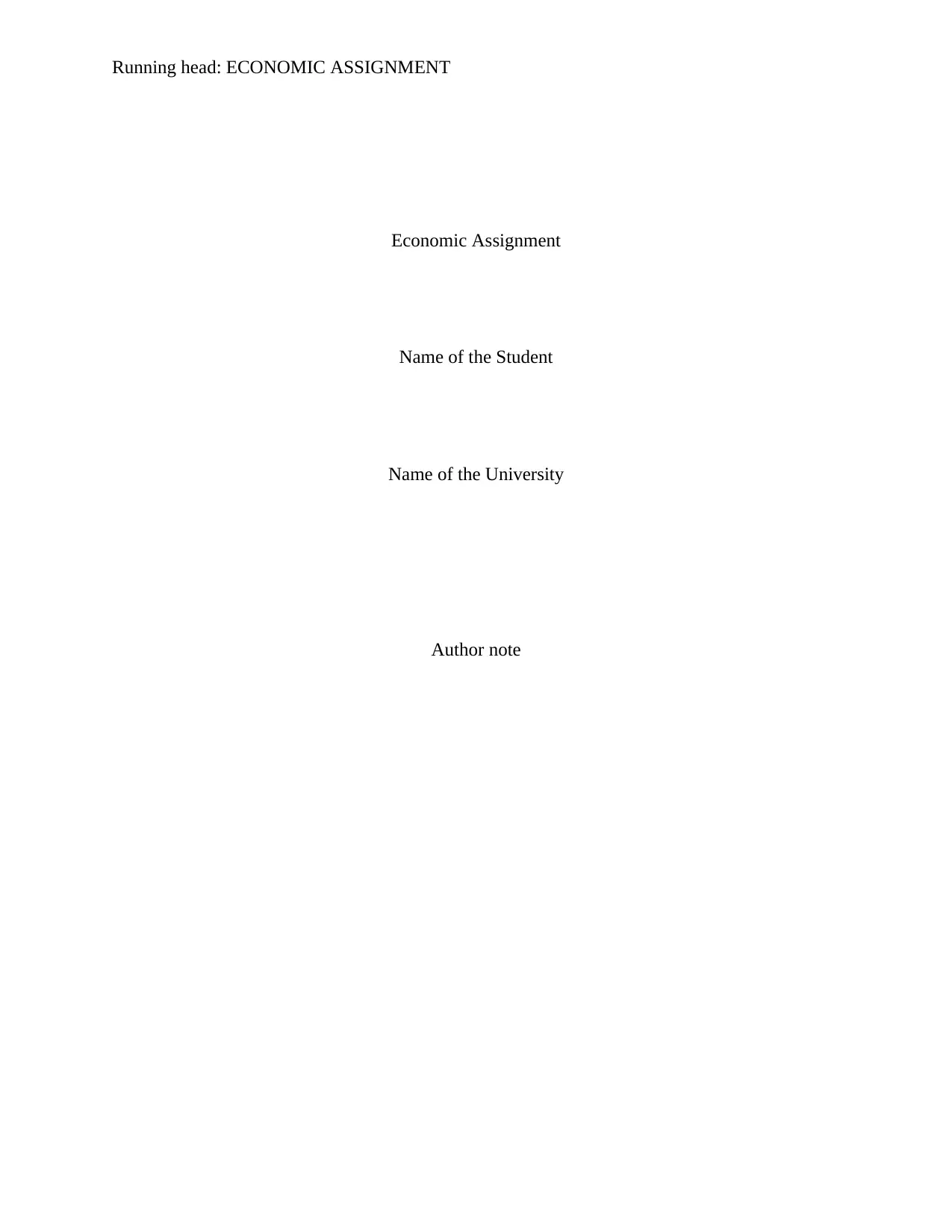
Running head: ECONOMIC ASSIGNMENT
Economic Assignment
Name of the Student
Name of the University
Author note
Economic Assignment
Name of the Student
Name of the University
Author note
Paraphrase This Document
Need a fresh take? Get an instant paraphrase of this document with our AI Paraphraser
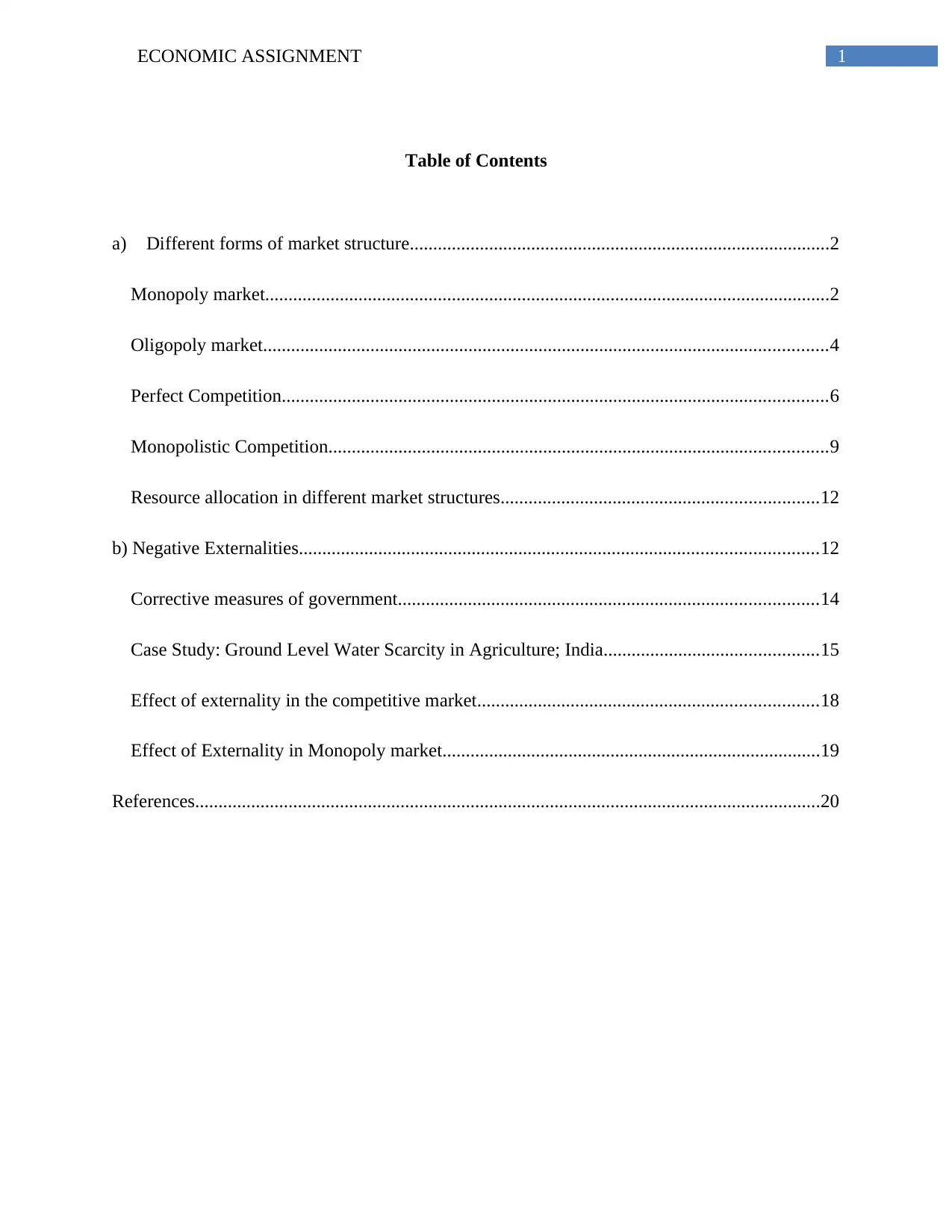
1ECONOMIC ASSIGNMENT
Table of Contents
a) Different forms of market structure..........................................................................................2
Monopoly market.........................................................................................................................2
Oligopoly market.........................................................................................................................4
Perfect Competition.....................................................................................................................6
Monopolistic Competition...........................................................................................................9
Resource allocation in different market structures....................................................................12
b) Negative Externalities...............................................................................................................12
Corrective measures of government..........................................................................................14
Case Study: Ground Level Water Scarcity in Agriculture; India..............................................15
Effect of externality in the competitive market.........................................................................18
Effect of Externality in Monopoly market.................................................................................19
References......................................................................................................................................20
Table of Contents
a) Different forms of market structure..........................................................................................2
Monopoly market.........................................................................................................................2
Oligopoly market.........................................................................................................................4
Perfect Competition.....................................................................................................................6
Monopolistic Competition...........................................................................................................9
Resource allocation in different market structures....................................................................12
b) Negative Externalities...............................................................................................................12
Corrective measures of government..........................................................................................14
Case Study: Ground Level Water Scarcity in Agriculture; India..............................................15
Effect of externality in the competitive market.........................................................................18
Effect of Externality in Monopoly market.................................................................................19
References......................................................................................................................................20
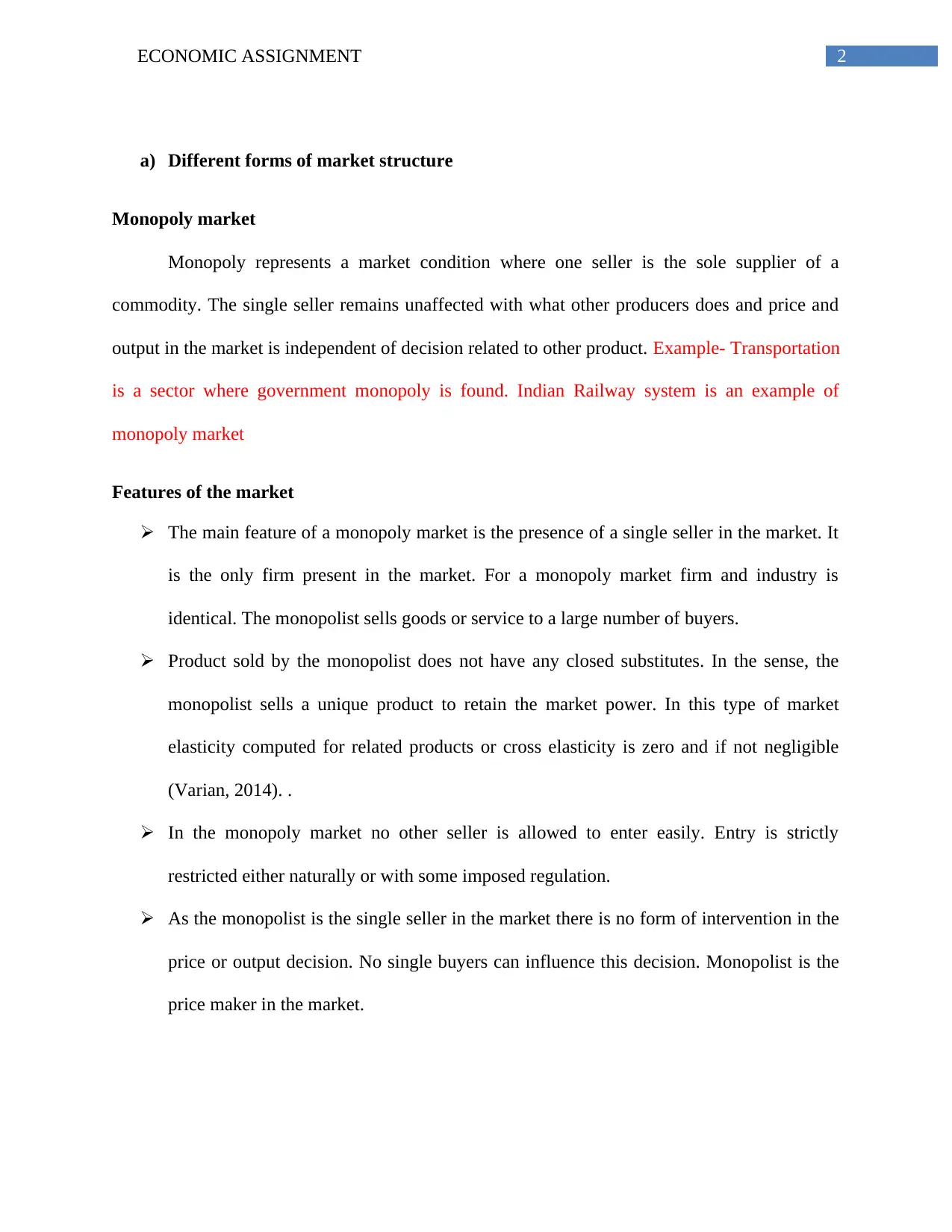
2ECONOMIC ASSIGNMENT
a) Different forms of market structure
Monopoly market
Monopoly represents a market condition where one seller is the sole supplier of a
commodity. The single seller remains unaffected with what other producers does and price and
output in the market is independent of decision related to other product. Example- Transportation
is a sector where government monopoly is found. Indian Railway system is an example of
monopoly market
Features of the market
The main feature of a monopoly market is the presence of a single seller in the market. It
is the only firm present in the market. For a monopoly market firm and industry is
identical. The monopolist sells goods or service to a large number of buyers.
Product sold by the monopolist does not have any closed substitutes. In the sense, the
monopolist sells a unique product to retain the market power. In this type of market
elasticity computed for related products or cross elasticity is zero and if not negligible
(Varian, 2014). .
In the monopoly market no other seller is allowed to enter easily. Entry is strictly
restricted either naturally or with some imposed regulation.
As the monopolist is the single seller in the market there is no form of intervention in the
price or output decision. No single buyers can influence this decision. Monopolist is the
price maker in the market.
a) Different forms of market structure
Monopoly market
Monopoly represents a market condition where one seller is the sole supplier of a
commodity. The single seller remains unaffected with what other producers does and price and
output in the market is independent of decision related to other product. Example- Transportation
is a sector where government monopoly is found. Indian Railway system is an example of
monopoly market
Features of the market
The main feature of a monopoly market is the presence of a single seller in the market. It
is the only firm present in the market. For a monopoly market firm and industry is
identical. The monopolist sells goods or service to a large number of buyers.
Product sold by the monopolist does not have any closed substitutes. In the sense, the
monopolist sells a unique product to retain the market power. In this type of market
elasticity computed for related products or cross elasticity is zero and if not negligible
(Varian, 2014). .
In the monopoly market no other seller is allowed to enter easily. Entry is strictly
restricted either naturally or with some imposed regulation.
As the monopolist is the single seller in the market there is no form of intervention in the
price or output decision. No single buyers can influence this decision. Monopolist is the
price maker in the market.
⊘ This is a preview!⊘
Do you want full access?
Subscribe today to unlock all pages.

Trusted by 1+ million students worldwide
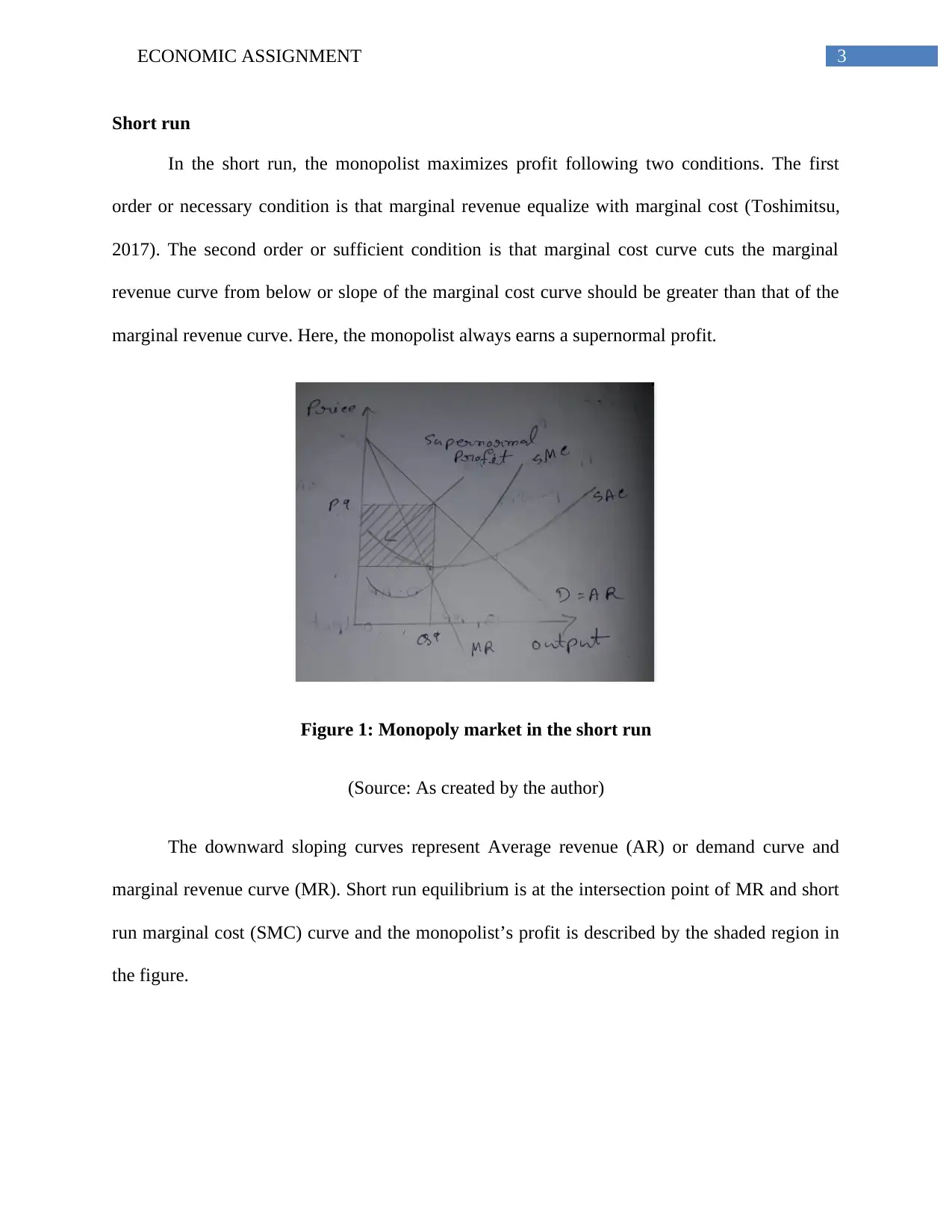
3ECONOMIC ASSIGNMENT
Short run
In the short run, the monopolist maximizes profit following two conditions. The first
order or necessary condition is that marginal revenue equalize with marginal cost (Toshimitsu,
2017). The second order or sufficient condition is that marginal cost curve cuts the marginal
revenue curve from below or slope of the marginal cost curve should be greater than that of the
marginal revenue curve. Here, the monopolist always earns a supernormal profit.
Figure 1: Monopoly market in the short run
(Source: As created by the author)
The downward sloping curves represent Average revenue (AR) or demand curve and
marginal revenue curve (MR). Short run equilibrium is at the intersection point of MR and short
run marginal cost (SMC) curve and the monopolist’s profit is described by the shaded region in
the figure.
Short run
In the short run, the monopolist maximizes profit following two conditions. The first
order or necessary condition is that marginal revenue equalize with marginal cost (Toshimitsu,
2017). The second order or sufficient condition is that marginal cost curve cuts the marginal
revenue curve from below or slope of the marginal cost curve should be greater than that of the
marginal revenue curve. Here, the monopolist always earns a supernormal profit.
Figure 1: Monopoly market in the short run
(Source: As created by the author)
The downward sloping curves represent Average revenue (AR) or demand curve and
marginal revenue curve (MR). Short run equilibrium is at the intersection point of MR and short
run marginal cost (SMC) curve and the monopolist’s profit is described by the shaded region in
the figure.
Paraphrase This Document
Need a fresh take? Get an instant paraphrase of this document with our AI Paraphraser
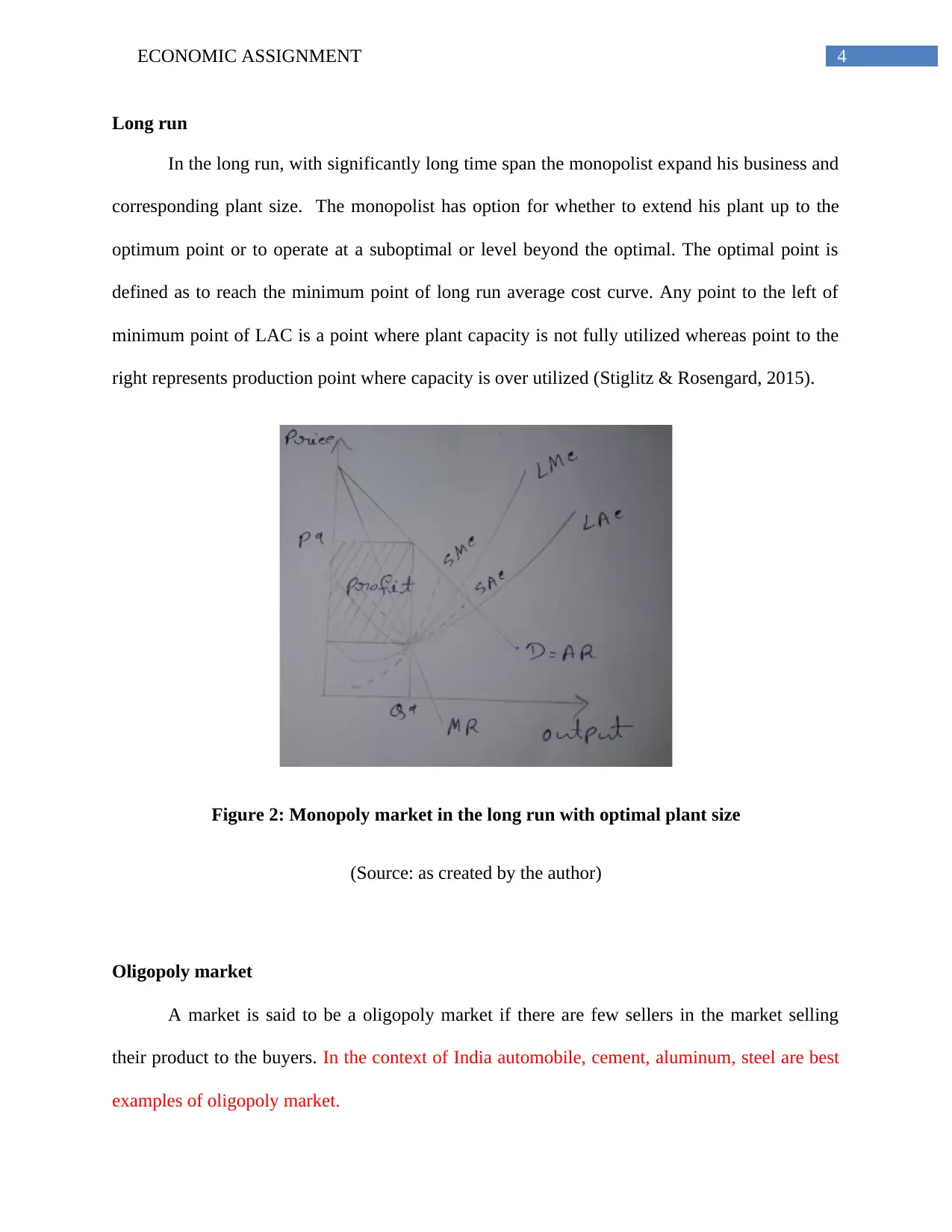
4ECONOMIC ASSIGNMENT
Long run
In the long run, with significantly long time span the monopolist expand his business and
corresponding plant size. The monopolist has option for whether to extend his plant up to the
optimum point or to operate at a suboptimal or level beyond the optimal. The optimal point is
defined as to reach the minimum point of long run average cost curve. Any point to the left of
minimum point of LAC is a point where plant capacity is not fully utilized whereas point to the
right represents production point where capacity is over utilized (Stiglitz & Rosengard, 2015).
Figure 2: Monopoly market in the long run with optimal plant size
(Source: as created by the author)
Oligopoly market
A market is said to be a oligopoly market if there are few sellers in the market selling
their product to the buyers. In the context of India automobile, cement, aluminum, steel are best
examples of oligopoly market.
Long run
In the long run, with significantly long time span the monopolist expand his business and
corresponding plant size. The monopolist has option for whether to extend his plant up to the
optimum point or to operate at a suboptimal or level beyond the optimal. The optimal point is
defined as to reach the minimum point of long run average cost curve. Any point to the left of
minimum point of LAC is a point where plant capacity is not fully utilized whereas point to the
right represents production point where capacity is over utilized (Stiglitz & Rosengard, 2015).
Figure 2: Monopoly market in the long run with optimal plant size
(Source: as created by the author)
Oligopoly market
A market is said to be a oligopoly market if there are few sellers in the market selling
their product to the buyers. In the context of India automobile, cement, aluminum, steel are best
examples of oligopoly market.
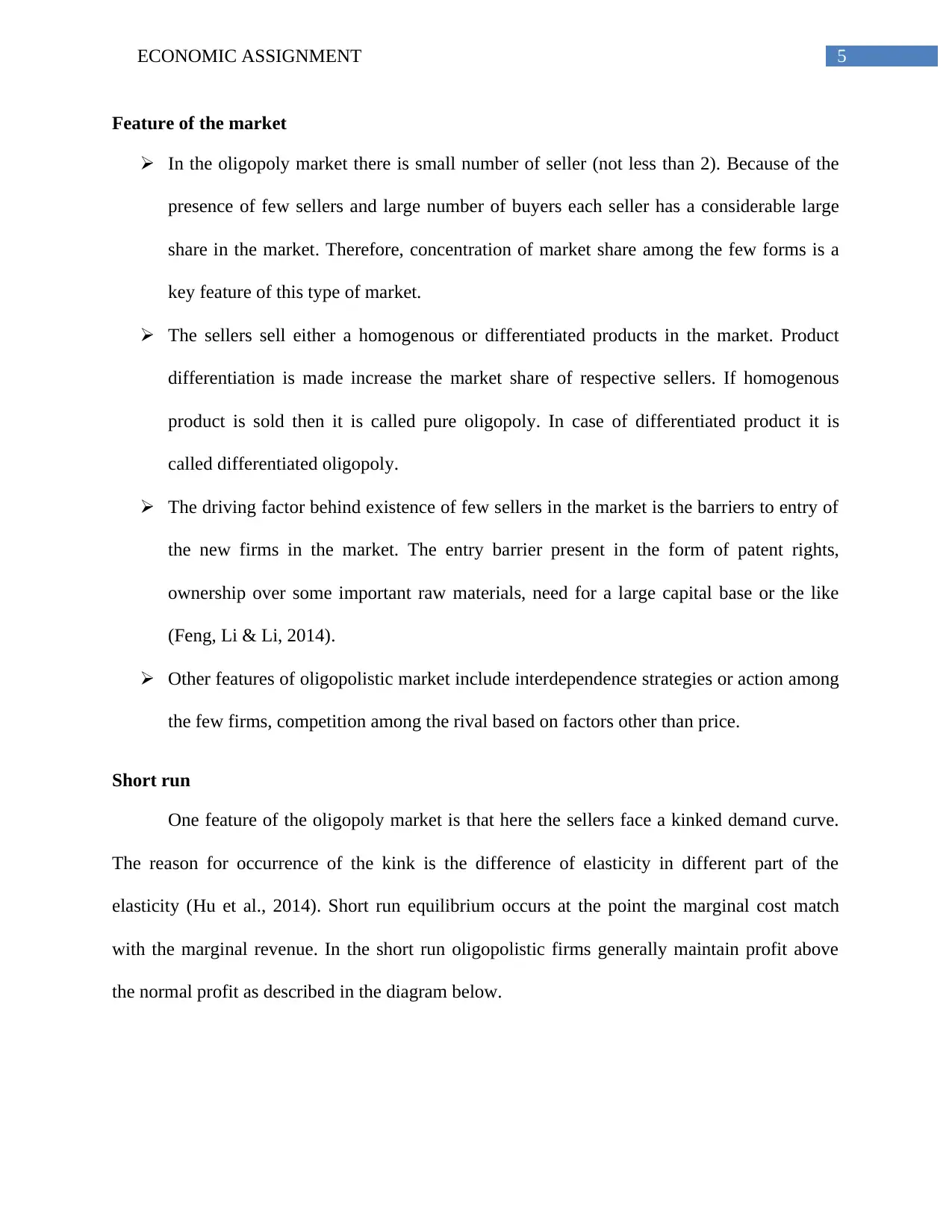
5ECONOMIC ASSIGNMENT
Feature of the market
In the oligopoly market there is small number of seller (not less than 2). Because of the
presence of few sellers and large number of buyers each seller has a considerable large
share in the market. Therefore, concentration of market share among the few forms is a
key feature of this type of market.
The sellers sell either a homogenous or differentiated products in the market. Product
differentiation is made increase the market share of respective sellers. If homogenous
product is sold then it is called pure oligopoly. In case of differentiated product it is
called differentiated oligopoly.
The driving factor behind existence of few sellers in the market is the barriers to entry of
the new firms in the market. The entry barrier present in the form of patent rights,
ownership over some important raw materials, need for a large capital base or the like
(Feng, Li & Li, 2014).
Other features of oligopolistic market include interdependence strategies or action among
the few firms, competition among the rival based on factors other than price.
Short run
One feature of the oligopoly market is that here the sellers face a kinked demand curve.
The reason for occurrence of the kink is the difference of elasticity in different part of the
elasticity (Hu et al., 2014). Short run equilibrium occurs at the point the marginal cost match
with the marginal revenue. In the short run oligopolistic firms generally maintain profit above
the normal profit as described in the diagram below.
Feature of the market
In the oligopoly market there is small number of seller (not less than 2). Because of the
presence of few sellers and large number of buyers each seller has a considerable large
share in the market. Therefore, concentration of market share among the few forms is a
key feature of this type of market.
The sellers sell either a homogenous or differentiated products in the market. Product
differentiation is made increase the market share of respective sellers. If homogenous
product is sold then it is called pure oligopoly. In case of differentiated product it is
called differentiated oligopoly.
The driving factor behind existence of few sellers in the market is the barriers to entry of
the new firms in the market. The entry barrier present in the form of patent rights,
ownership over some important raw materials, need for a large capital base or the like
(Feng, Li & Li, 2014).
Other features of oligopolistic market include interdependence strategies or action among
the few firms, competition among the rival based on factors other than price.
Short run
One feature of the oligopoly market is that here the sellers face a kinked demand curve.
The reason for occurrence of the kink is the difference of elasticity in different part of the
elasticity (Hu et al., 2014). Short run equilibrium occurs at the point the marginal cost match
with the marginal revenue. In the short run oligopolistic firms generally maintain profit above
the normal profit as described in the diagram below.
⊘ This is a preview!⊘
Do you want full access?
Subscribe today to unlock all pages.

Trusted by 1+ million students worldwide
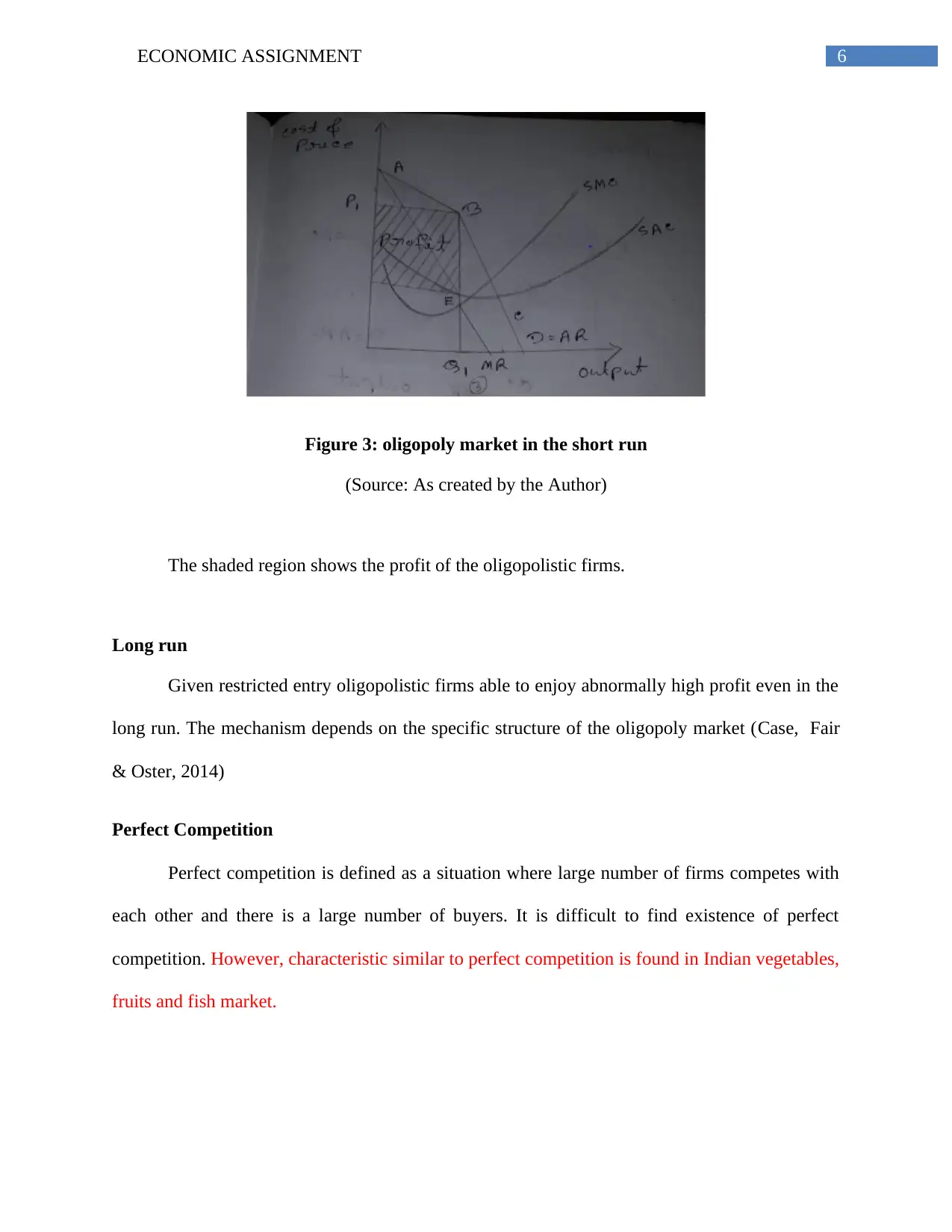
6ECONOMIC ASSIGNMENT
Figure 3: oligopoly market in the short run
(Source: As created by the Author)
The shaded region shows the profit of the oligopolistic firms.
Long run
Given restricted entry oligopolistic firms able to enjoy abnormally high profit even in the
long run. The mechanism depends on the specific structure of the oligopoly market (Case, Fair
& Oster, 2014)
Perfect Competition
Perfect competition is defined as a situation where large number of firms competes with
each other and there is a large number of buyers. It is difficult to find existence of perfect
competition. However, characteristic similar to perfect competition is found in Indian vegetables,
fruits and fish market.
Figure 3: oligopoly market in the short run
(Source: As created by the Author)
The shaded region shows the profit of the oligopolistic firms.
Long run
Given restricted entry oligopolistic firms able to enjoy abnormally high profit even in the
long run. The mechanism depends on the specific structure of the oligopoly market (Case, Fair
& Oster, 2014)
Perfect Competition
Perfect competition is defined as a situation where large number of firms competes with
each other and there is a large number of buyers. It is difficult to find existence of perfect
competition. However, characteristic similar to perfect competition is found in Indian vegetables,
fruits and fish market.
Paraphrase This Document
Need a fresh take? Get an instant paraphrase of this document with our AI Paraphraser
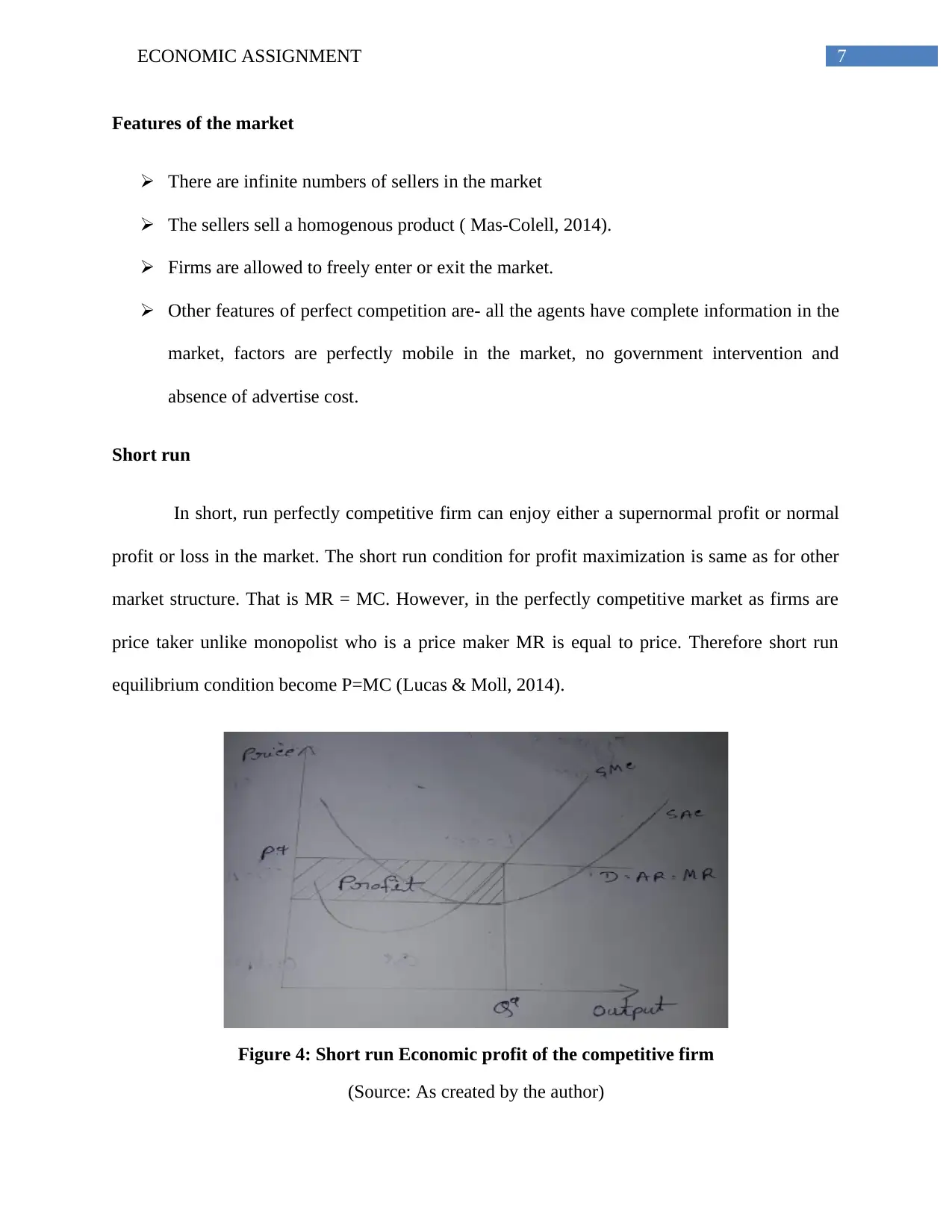
7ECONOMIC ASSIGNMENT
Features of the market
There are infinite numbers of sellers in the market
The sellers sell a homogenous product ( Mas-Colell, 2014).
Firms are allowed to freely enter or exit the market.
Other features of perfect competition are- all the agents have complete information in the
market, factors are perfectly mobile in the market, no government intervention and
absence of advertise cost.
Short run
In short, run perfectly competitive firm can enjoy either a supernormal profit or normal
profit or loss in the market. The short run condition for profit maximization is same as for other
market structure. That is MR = MC. However, in the perfectly competitive market as firms are
price taker unlike monopolist who is a price maker MR is equal to price. Therefore short run
equilibrium condition become P=MC (Lucas & Moll, 2014).
Figure 4: Short run Economic profit of the competitive firm
(Source: As created by the author)
Features of the market
There are infinite numbers of sellers in the market
The sellers sell a homogenous product ( Mas-Colell, 2014).
Firms are allowed to freely enter or exit the market.
Other features of perfect competition are- all the agents have complete information in the
market, factors are perfectly mobile in the market, no government intervention and
absence of advertise cost.
Short run
In short, run perfectly competitive firm can enjoy either a supernormal profit or normal
profit or loss in the market. The short run condition for profit maximization is same as for other
market structure. That is MR = MC. However, in the perfectly competitive market as firms are
price taker unlike monopolist who is a price maker MR is equal to price. Therefore short run
equilibrium condition become P=MC (Lucas & Moll, 2014).
Figure 4: Short run Economic profit of the competitive firm
(Source: As created by the author)
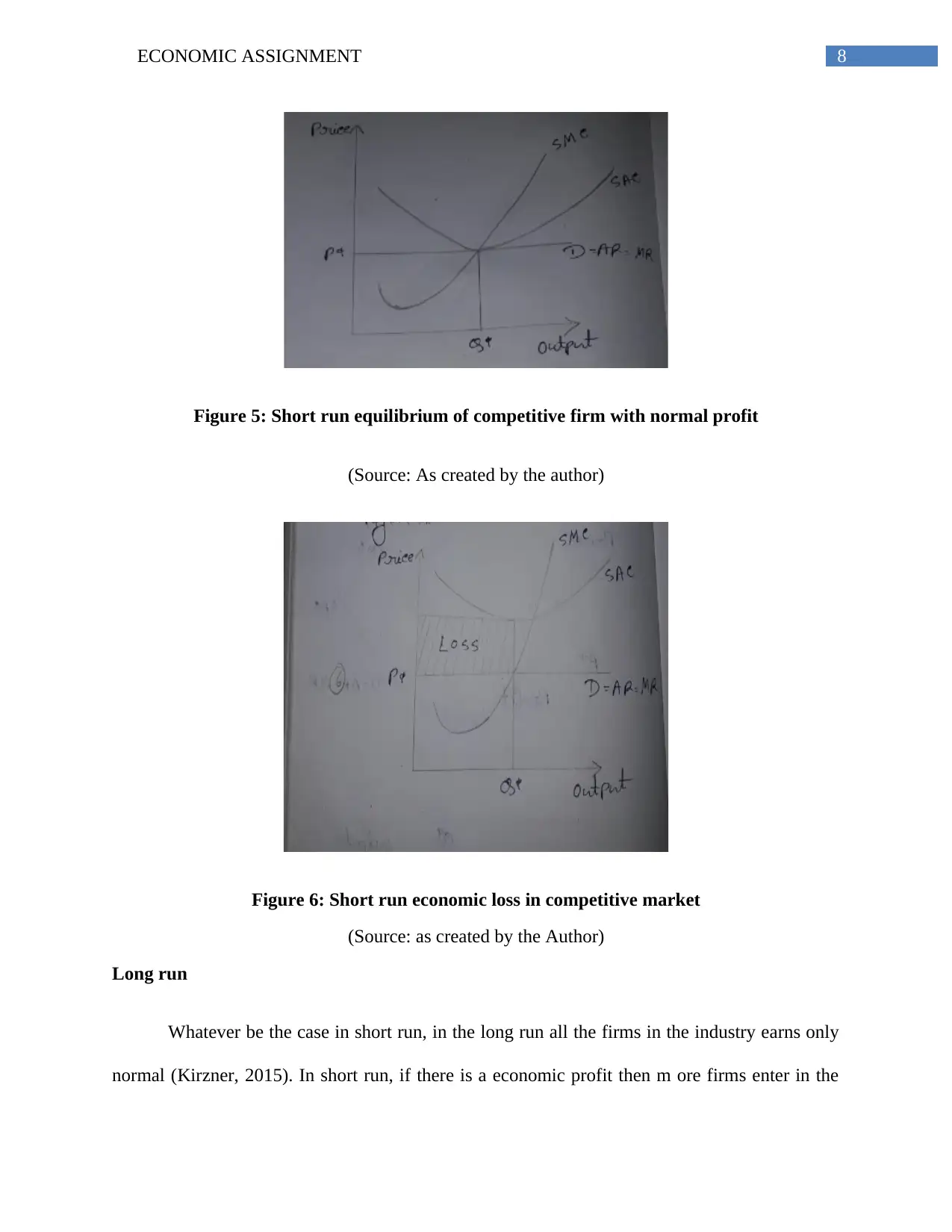
8ECONOMIC ASSIGNMENT
Figure 5: Short run equilibrium of competitive firm with normal profit
(Source: As created by the author)
Figure 6: Short run economic loss in competitive market
(Source: as created by the Author)
Long run
Whatever be the case in short run, in the long run all the firms in the industry earns only
normal (Kirzner, 2015). In short run, if there is a economic profit then m ore firms enter in the
Figure 5: Short run equilibrium of competitive firm with normal profit
(Source: As created by the author)
Figure 6: Short run economic loss in competitive market
(Source: as created by the Author)
Long run
Whatever be the case in short run, in the long run all the firms in the industry earns only
normal (Kirzner, 2015). In short run, if there is a economic profit then m ore firms enter in the
⊘ This is a preview!⊘
Do you want full access?
Subscribe today to unlock all pages.

Trusted by 1+ million students worldwide
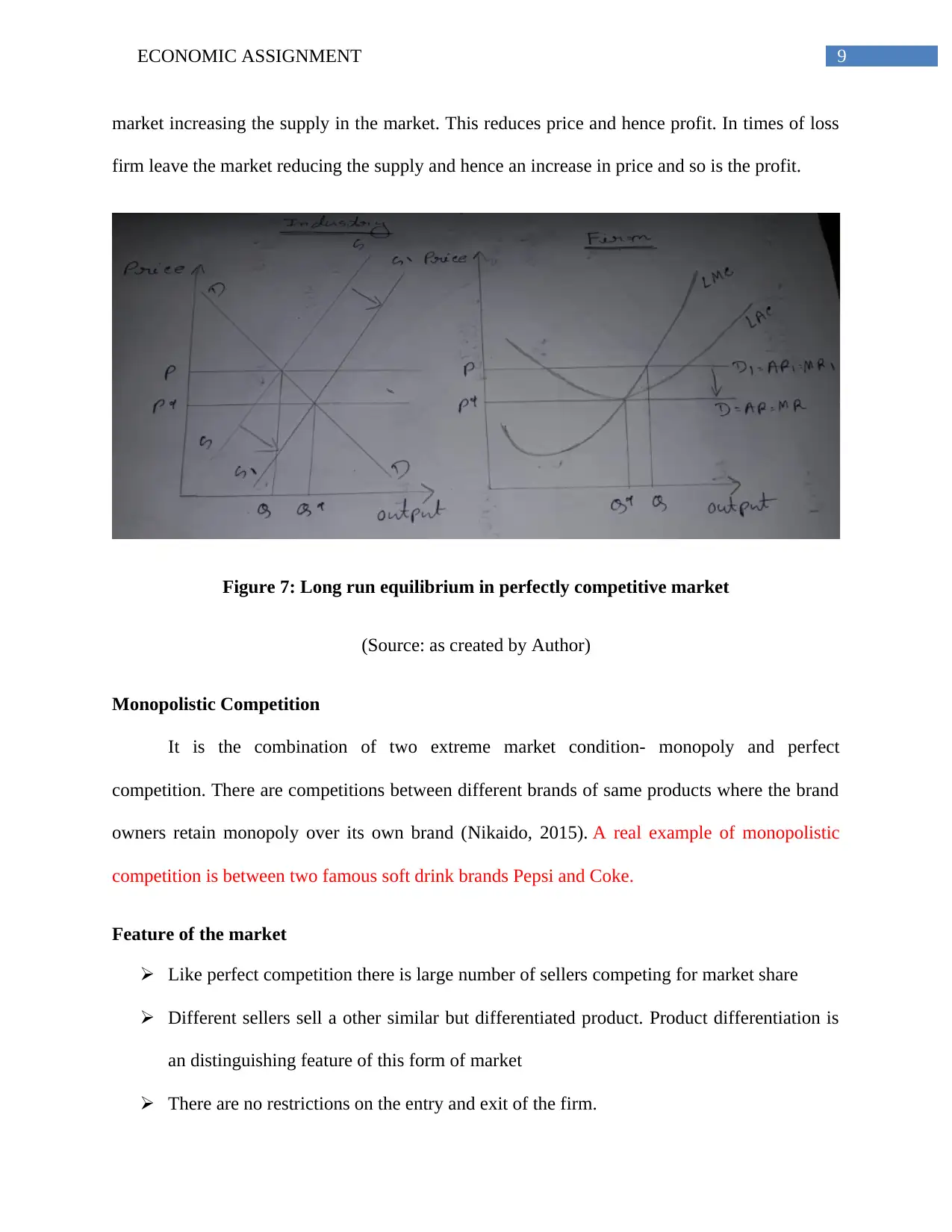
9ECONOMIC ASSIGNMENT
market increasing the supply in the market. This reduces price and hence profit. In times of loss
firm leave the market reducing the supply and hence an increase in price and so is the profit.
Figure 7: Long run equilibrium in perfectly competitive market
(Source: as created by Author)
Monopolistic Competition
It is the combination of two extreme market condition- monopoly and perfect
competition. There are competitions between different brands of same products where the brand
owners retain monopoly over its own brand (Nikaido, 2015). A real example of monopolistic
competition is between two famous soft drink brands Pepsi and Coke.
Feature of the market
Like perfect competition there is large number of sellers competing for market share
Different sellers sell a other similar but differentiated product. Product differentiation is
an distinguishing feature of this form of market
There are no restrictions on the entry and exit of the firm.
market increasing the supply in the market. This reduces price and hence profit. In times of loss
firm leave the market reducing the supply and hence an increase in price and so is the profit.
Figure 7: Long run equilibrium in perfectly competitive market
(Source: as created by Author)
Monopolistic Competition
It is the combination of two extreme market condition- monopoly and perfect
competition. There are competitions between different brands of same products where the brand
owners retain monopoly over its own brand (Nikaido, 2015). A real example of monopolistic
competition is between two famous soft drink brands Pepsi and Coke.
Feature of the market
Like perfect competition there is large number of sellers competing for market share
Different sellers sell a other similar but differentiated product. Product differentiation is
an distinguishing feature of this form of market
There are no restrictions on the entry and exit of the firm.
Paraphrase This Document
Need a fresh take? Get an instant paraphrase of this document with our AI Paraphraser
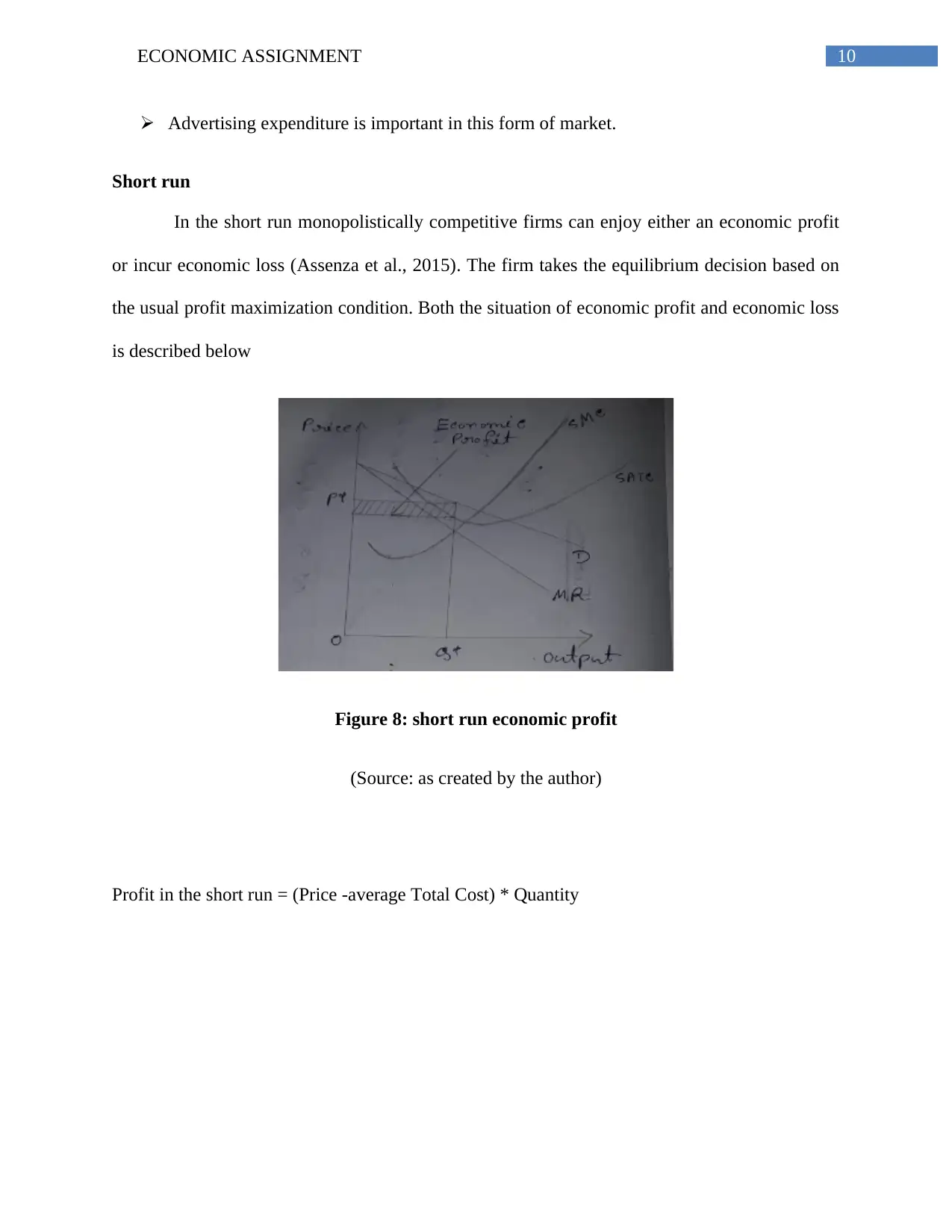
10ECONOMIC ASSIGNMENT
Advertising expenditure is important in this form of market.
Short run
In the short run monopolistically competitive firms can enjoy either an economic profit
or incur economic loss (Assenza et al., 2015). The firm takes the equilibrium decision based on
the usual profit maximization condition. Both the situation of economic profit and economic loss
is described below
Figure 8: short run economic profit
(Source: as created by the author)
Profit in the short run = (Price -average Total Cost) * Quantity
Advertising expenditure is important in this form of market.
Short run
In the short run monopolistically competitive firms can enjoy either an economic profit
or incur economic loss (Assenza et al., 2015). The firm takes the equilibrium decision based on
the usual profit maximization condition. Both the situation of economic profit and economic loss
is described below
Figure 8: short run economic profit
(Source: as created by the author)
Profit in the short run = (Price -average Total Cost) * Quantity
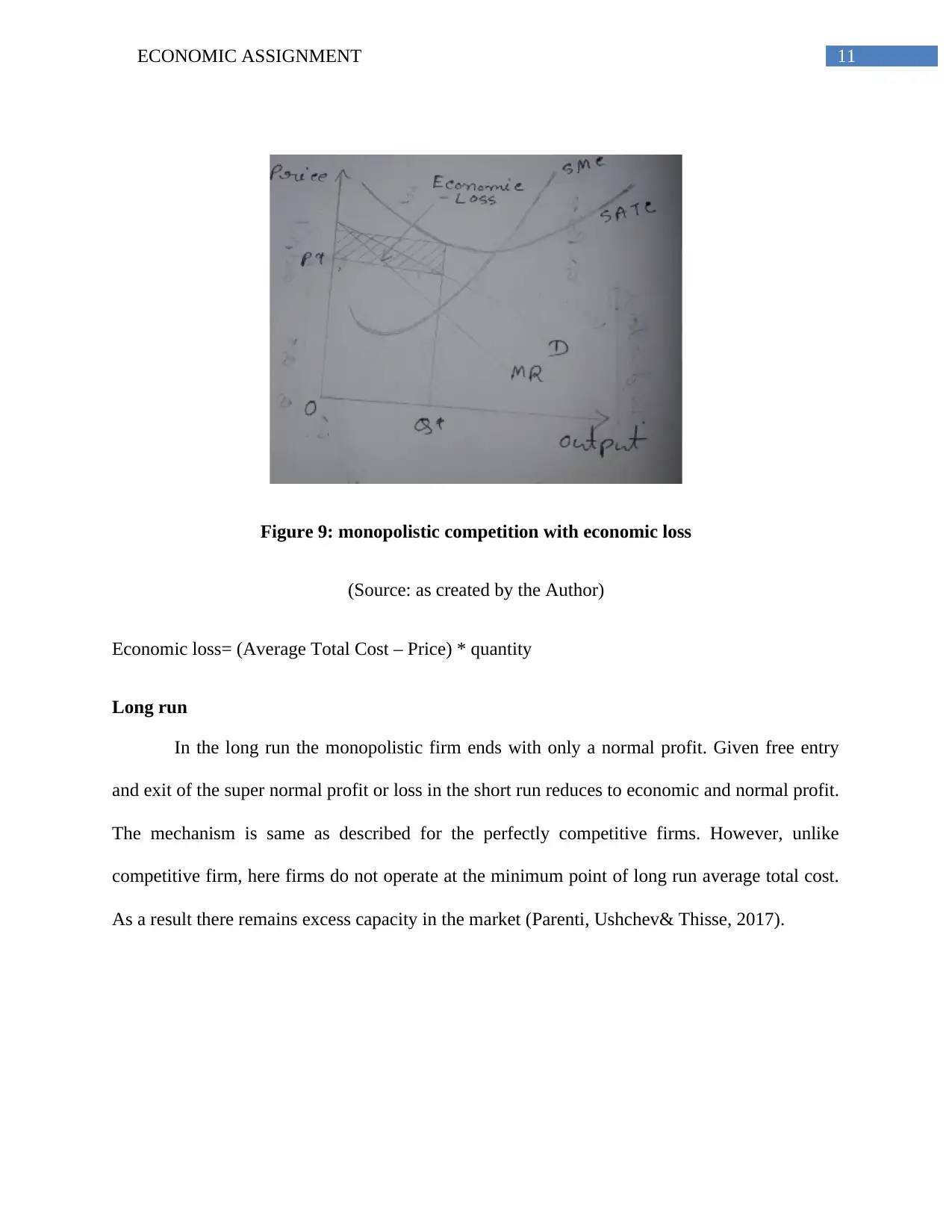
11ECONOMIC ASSIGNMENT
Figure 9: monopolistic competition with economic loss
(Source: as created by the Author)
Economic loss= (Average Total Cost – Price) * quantity
Long run
In the long run the monopolistic firm ends with only a normal profit. Given free entry
and exit of the super normal profit or loss in the short run reduces to economic and normal profit.
The mechanism is same as described for the perfectly competitive firms. However, unlike
competitive firm, here firms do not operate at the minimum point of long run average total cost.
As a result there remains excess capacity in the market (Parenti, Ushchev& Thisse, 2017).
Figure 9: monopolistic competition with economic loss
(Source: as created by the Author)
Economic loss= (Average Total Cost – Price) * quantity
Long run
In the long run the monopolistic firm ends with only a normal profit. Given free entry
and exit of the super normal profit or loss in the short run reduces to economic and normal profit.
The mechanism is same as described for the perfectly competitive firms. However, unlike
competitive firm, here firms do not operate at the minimum point of long run average total cost.
As a result there remains excess capacity in the market (Parenti, Ushchev& Thisse, 2017).
⊘ This is a preview!⊘
Do you want full access?
Subscribe today to unlock all pages.

Trusted by 1+ million students worldwide
1 out of 23
Related Documents
Your All-in-One AI-Powered Toolkit for Academic Success.
+13062052269
info@desklib.com
Available 24*7 on WhatsApp / Email
![[object Object]](/_next/static/media/star-bottom.7253800d.svg)
Unlock your academic potential
Copyright © 2020–2025 A2Z Services. All Rights Reserved. Developed and managed by ZUCOL.




